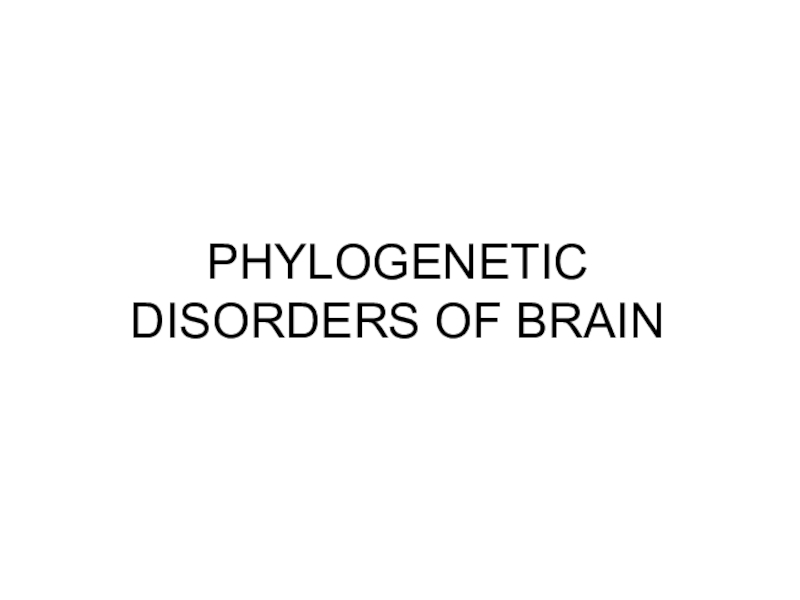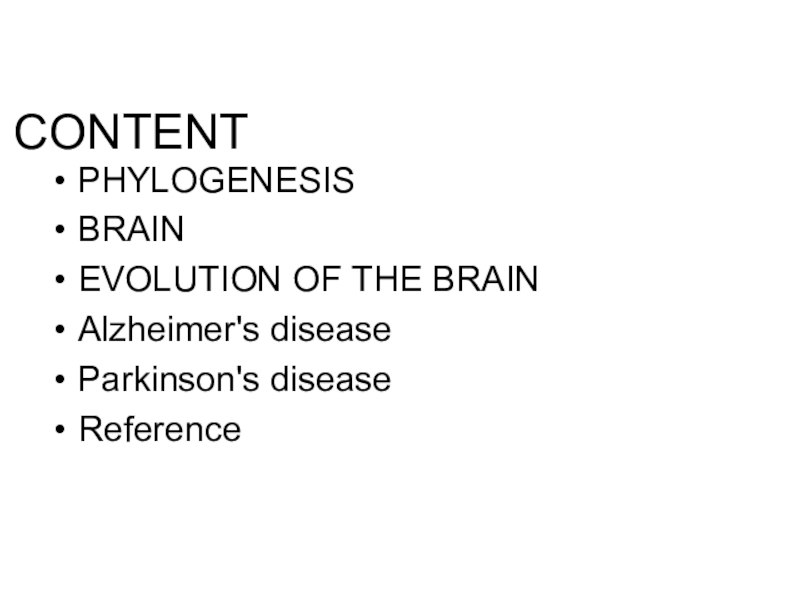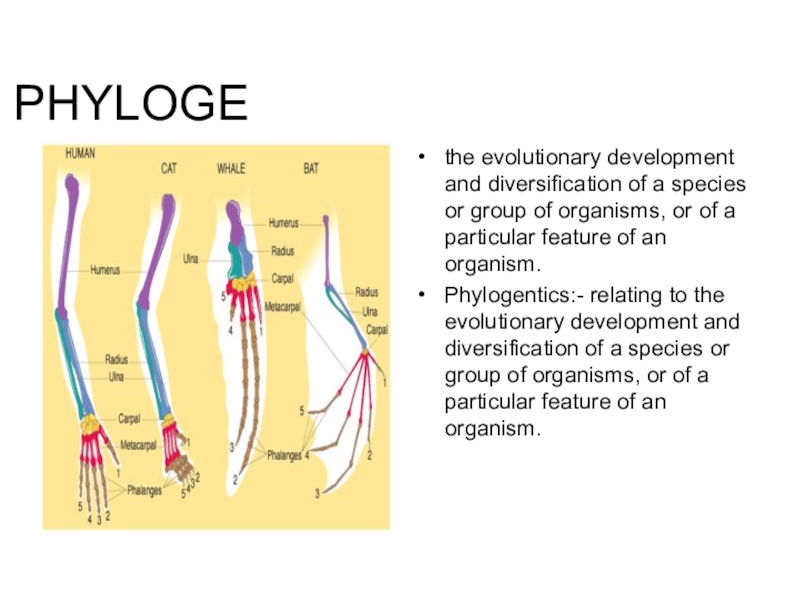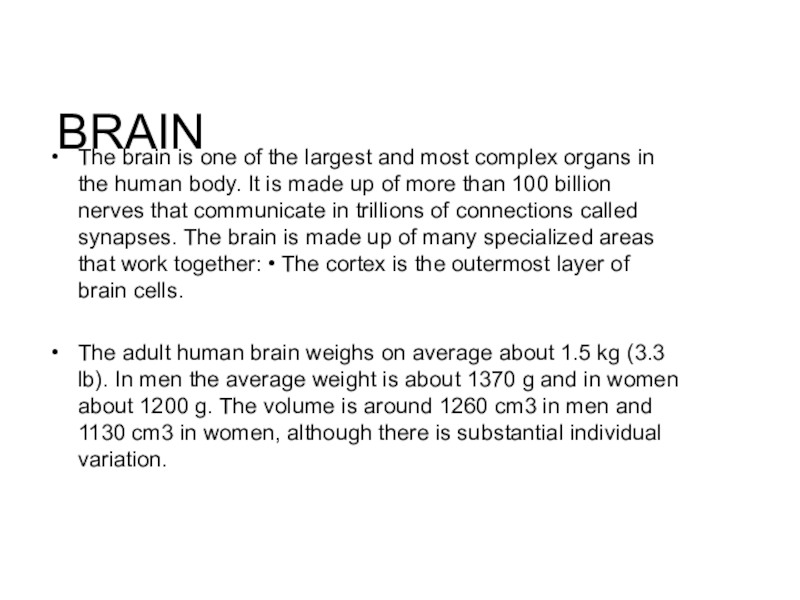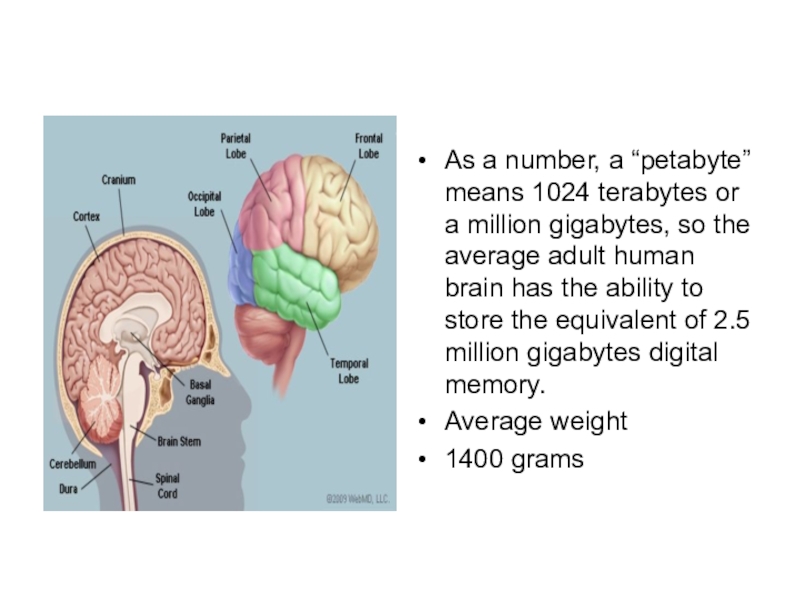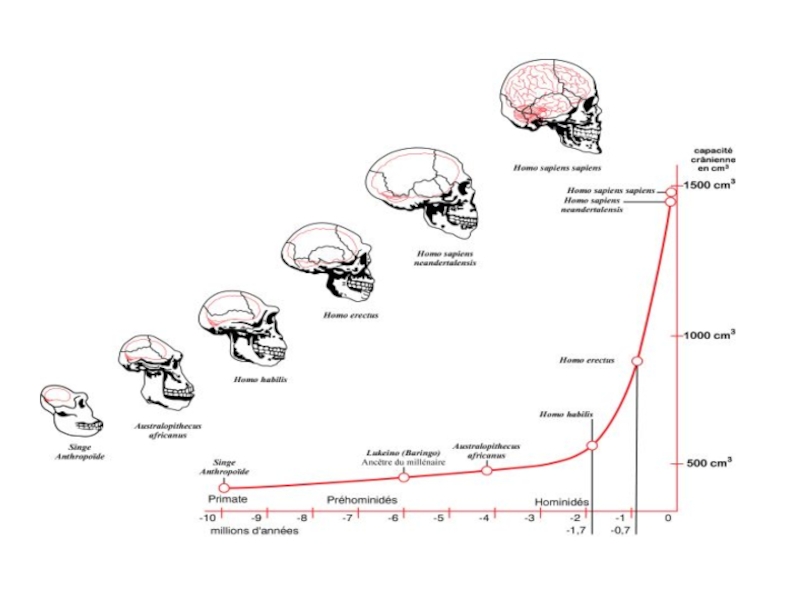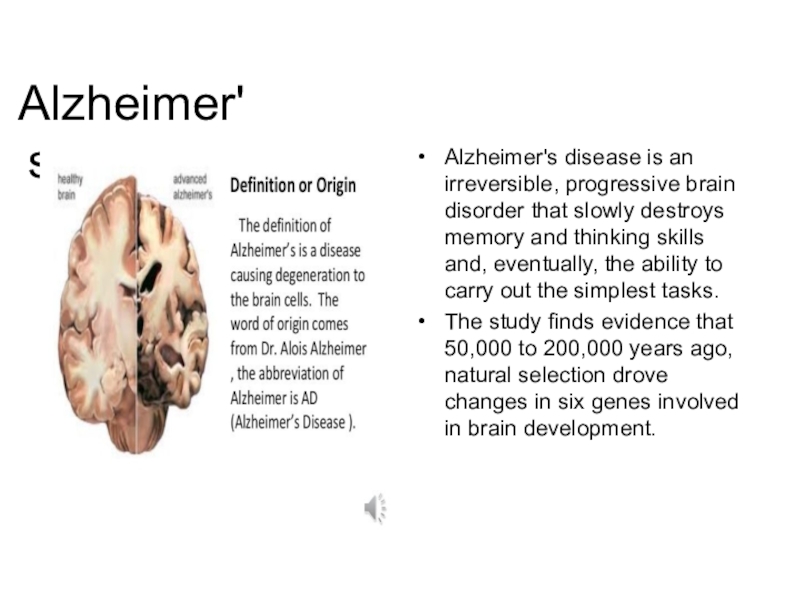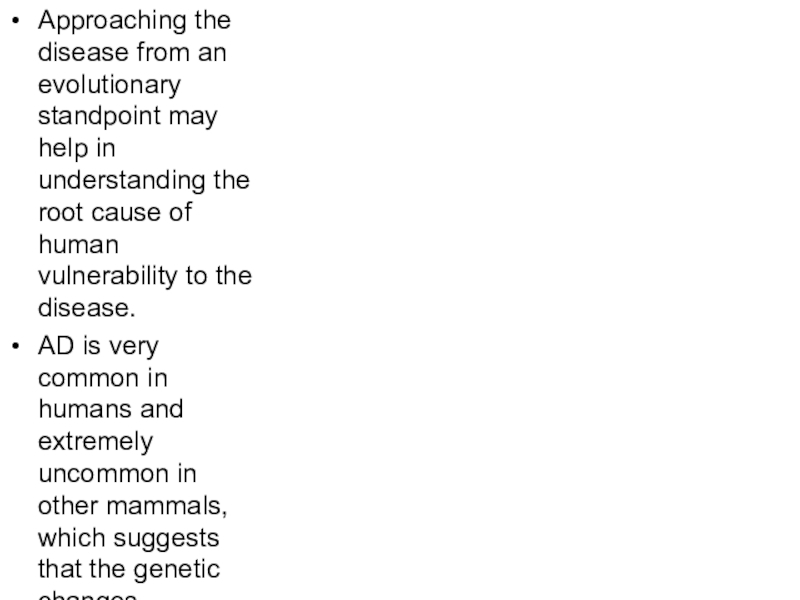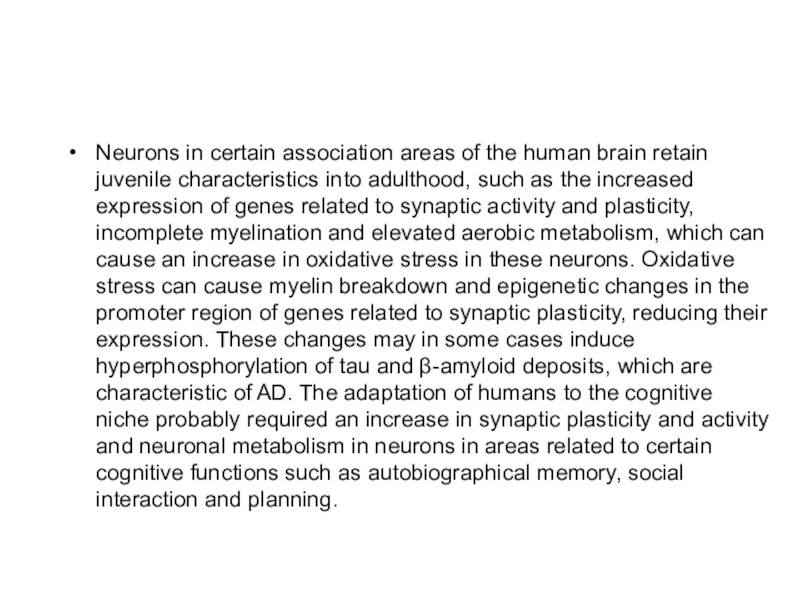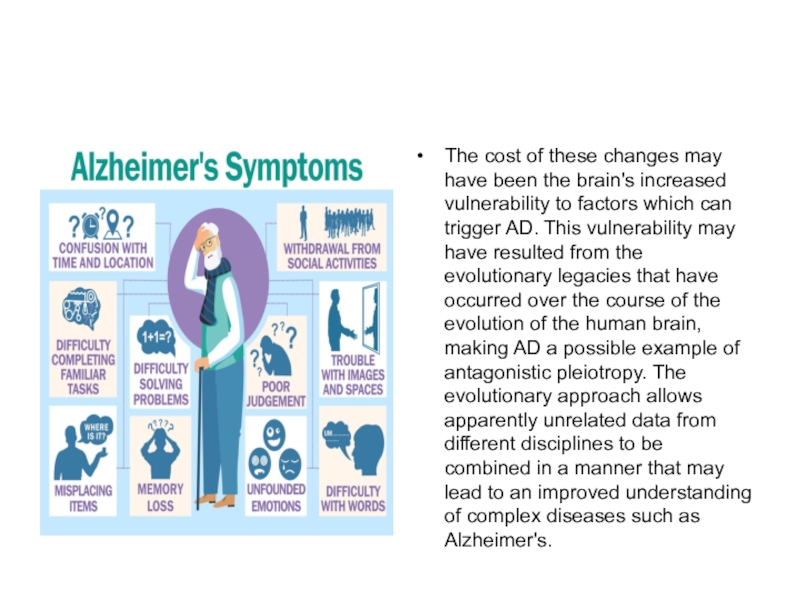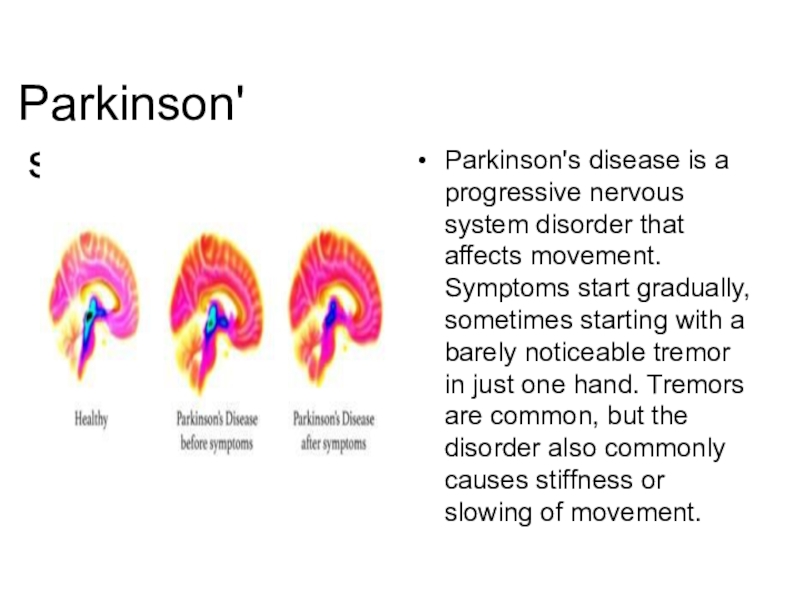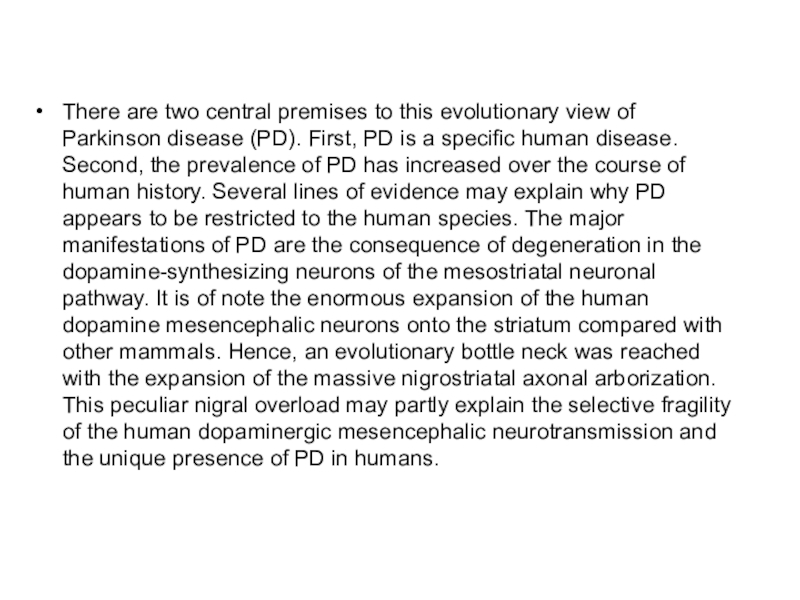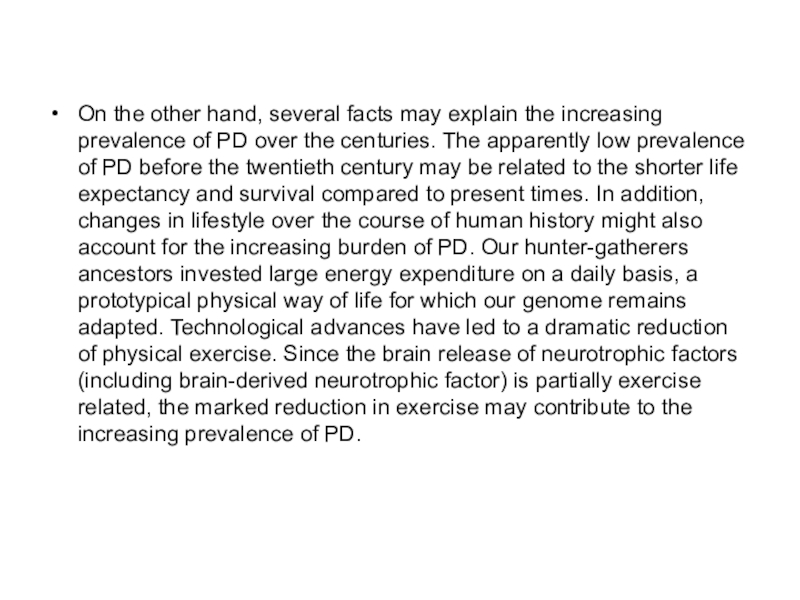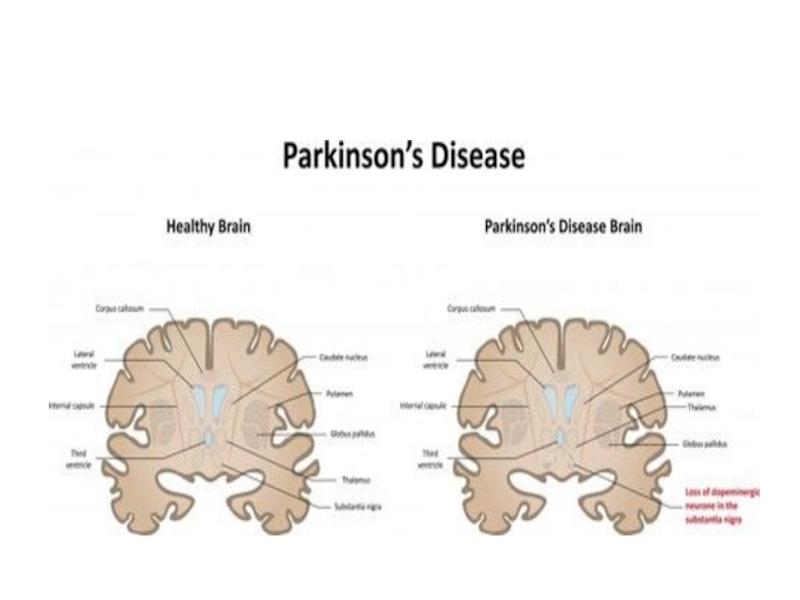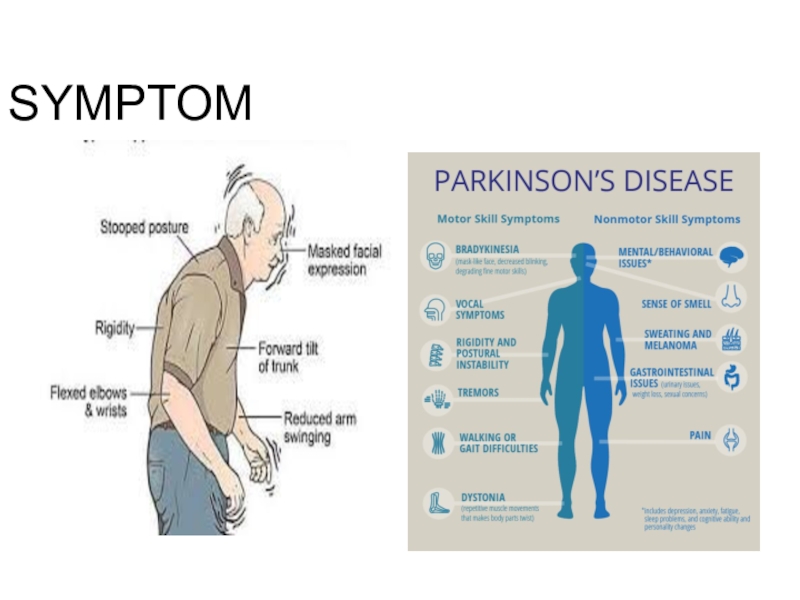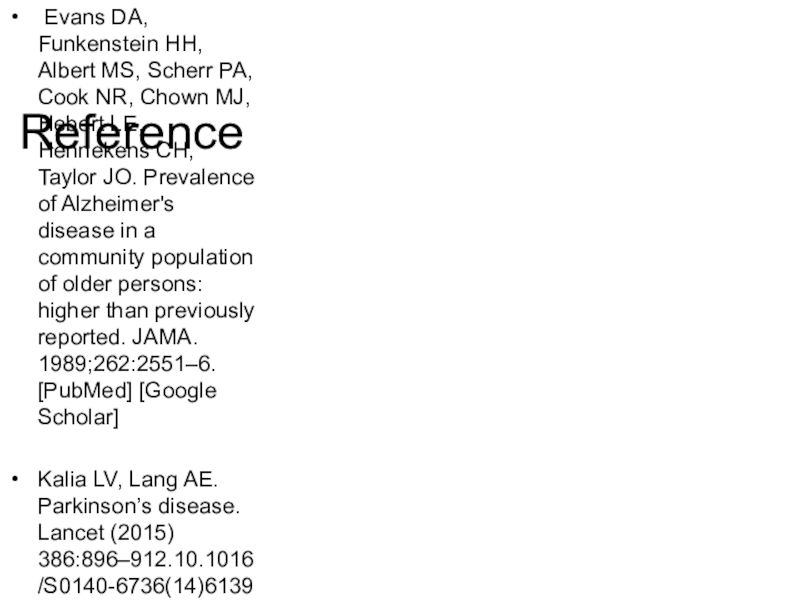Разделы презентаций
- Разное
- Английский язык
- Астрономия
- Алгебра
- Биология
- География
- Геометрия
- Детские презентации
- Информатика
- История
- Литература
- Математика
- Медицина
- Менеджмент
- Музыка
- МХК
- Немецкий язык
- ОБЖ
- Обществознание
- Окружающий мир
- Педагогика
- Русский язык
- Технология
- Физика
- Философия
- Химия
- Шаблоны, картинки для презентаций
- Экология
- Экономика
- Юриспруденция
CRIMEA STATE MEDICAL UNIVERSITY NAMED AFTER S.I. GEORGIEVSKY
Содержание
- 1. CRIMEA STATE MEDICAL UNIVERSITY NAMED AFTER S.I. GEORGIEVSKY
- 2. PHYLOGENETIC DISORDERS OF BRAIN
- 3. CONTENTPHYLOGENESISBRAINEVOLUTION OF THE BRAINAlzheimer's diseaseParkinson's diseaseReference
- 4. PHYLOGENESISthe evolutionary development and diversification of a
- 5. BRAIN The brain is one of the
- 6. As a number, a “petabyte” means 1024
- 7. EVOLUTION OF THE BRAINOne of the prominent
- 8. Слайд 8
- 9. Alzheimer's diseaseAlzheimer's disease is an irreversible, progressive
- 10. Approaching the disease from an evolutionary standpoint
- 11. Neurons in certain association areas of the
- 12. The cost of these changes may have
- 13. Parkinson's diseaseParkinson's disease is a progressive nervous
- 14. There are two central premises to this
- 15. On the other hand, several facts may
- 16. Слайд 16
- 17. SYMPTOMS
- 18. Reference Evans DA, Funkenstein HH, Albert MS,
- 19. THANKYOU!
- 20. Скачать презентанцию
PHYLOGENETIC DISORDERS OF BRAIN
Слайды и текст этой презентации
Слайд 1CRIMEA STATE MEDICAL UNIVERSITY
NAMED AFTER S.I. GEORGIEVSKY
Topic:- Phylogenetic disorders of
brain
Слайд 3CONTENT
PHYLOGENESIS
BRAIN
EVOLUTION OF THE BRAIN
Alzheimer's disease
Parkinson's disease
Reference
Слайд 4PHYLOGENESIS
the evolutionary development and diversification of a species or group
of organisms, or of a particular feature of an organism.
Phylogentics:-
relating to the evolutionary development and diversification of a species or group of organisms, or of a particular feature of an organism.Слайд 5BRAIN
The brain is one of the largest and most
complex organs in the human body. It is made up
of more than 100 billion nerves that communicate in trillions of connections called synapses. The brain is made up of many specialized areas that work together: • The cortex is the outermost layer of brain cells.The adult human brain weighs on average about 1.5 kg (3.3 lb). In men the average weight is about 1370 g and in women about 1200 g. The volume is around 1260 cm3 in men and 1130 cm3 in women, although there is substantial individual variation.
Слайд 6As a number, a “petabyte” means 1024 terabytes or a
million gigabytes, so the average adult human brain has the
ability to store the equivalent of 2.5 million gigabytes digital memory.Average weight
1400 grams
Слайд 7EVOLUTION OF THE BRAIN
One of the prominent ways of tracking
the evolution of the human brain is through direct evidence
in the form of fossils. The evolutionary history of the human brain shows primarily a gradually bigger brain relative to body size during the evolutionary path from early primates to hominids and finally to Homo sapiens.On average, the size of primates' brains is nearly double what is expected for mammals of the same body size. Across nearly seven million years, the human brain has tripled in size, with most of this growth occurring in the past two million years
Слайд 9Alzheimer's disease
Alzheimer's disease is an irreversible, progressive brain disorder that
slowly destroys memory and thinking skills and, eventually, the ability
to carry out the simplest tasks.The study finds evidence that 50,000 to 200,000 years ago, natural selection drove changes in six genes involved in brain development.
Слайд 10Approaching the disease from an evolutionary standpoint may help in
understanding the root cause of human vulnerability to the disease.
AD
is very common in humans and extremely uncommon in other mammals, which suggests that the genetic changes underlying the alterations in cerebral structure or function that have taken place over the course of the evolution of the genus Homo have left specific neurons in the human brain particularly vulnerable to factors which trigger the disease.Слайд 11Neurons in certain association areas of the human brain retain
juvenile characteristics into adulthood, such as the increased expression of
genes related to synaptic activity and plasticity, incomplete myelination and elevated aerobic metabolism, which can cause an increase in oxidative stress in these neurons. Oxidative stress can cause myelin breakdown and epigenetic changes in the promoter region of genes related to synaptic plasticity, reducing their expression. These changes may in some cases induce hyperphosphorylation of tau and β-amyloid deposits, which are characteristic of AD. The adaptation of humans to the cognitive niche probably required an increase in synaptic plasticity and activity and neuronal metabolism in neurons in areas related to certain cognitive functions such as autobiographical memory, social interaction and planning.Слайд 12The cost of these changes may have been the brain's
increased vulnerability to factors which can trigger AD. This vulnerability
may have resulted from the evolutionary legacies that have occurred over the course of the evolution of the human brain, making AD a possible example of antagonistic pleiotropy. The evolutionary approach allows apparently unrelated data from different disciplines to be combined in a manner that may lead to an improved understanding of complex diseases such as Alzheimer's.Слайд 13Parkinson's disease
Parkinson's disease is a progressive nervous system disorder that
affects movement. Symptoms start gradually, sometimes starting with a barely
noticeable tremor in just one hand. Tremors are common, but the disorder also commonly causes stiffness or slowing of movement.Слайд 14There are two central premises to this evolutionary view of
Parkinson disease (PD). First, PD is a specific human disease.
Second, the prevalence of PD has increased over the course of human history. Several lines of evidence may explain why PD appears to be restricted to the human species. The major manifestations of PD are the consequence of degeneration in the dopamine-synthesizing neurons of the mesostriatal neuronal pathway. It is of note the enormous expansion of the human dopamine mesencephalic neurons onto the striatum compared with other mammals. Hence, an evolutionary bottle neck was reached with the expansion of the massive nigrostriatal axonal arborization. This peculiar nigral overload may partly explain the selective fragility of the human dopaminergic mesencephalic neurotransmission and the unique presence of PD in humans.Слайд 15On the other hand, several facts may explain the increasing
prevalence of PD over the centuries. The apparently low prevalence
of PD before the twentieth century may be related to the shorter life expectancy and survival compared to present times. In addition, changes in lifestyle over the course of human history might also account for the increasing burden of PD. Our hunter-gatherers ancestors invested large energy expenditure on a daily basis, a prototypical physical way of life for which our genome remains adapted. Technological advances have led to a dramatic reduction of physical exercise. Since the brain release of neurotrophic factors (including brain-derived neurotrophic factor) is partially exercise related, the marked reduction in exercise may contribute to the increasing prevalence of PD.Слайд 18Reference
Evans DA, Funkenstein HH, Albert MS, Scherr PA, Cook
NR, Chown MJ, Hebert LE, Hennekens CH, Taylor JO. Prevalence
of Alzheimer's disease in a community population of older persons: higher than previously reported. JAMA. 1989;262:2551–6. [PubMed] [Google Scholar]Kalia LV, Lang AE. Parkinson’s disease. Lancet (2015) 386:896–912.10.1016/S0140-6736(14)61393-3 - DOI - PubMed
Wikipedia

